 | | | Switch to: Europe, USA, New Zealand, Antarctica Credit: NOAA/Ovation  Planetary K-index Planetary K-index
Now: Kp= 1.33 quiet
24-hr max: Kp= 1.67 quiet
explanation | more data
Interplanetary Mag. Field
Btotal: 5.36 nT
Bz: -1.54 nT south
more data: ACE, DSCOVR
Updated: Today at 1147 UT  Coronal Holes: 13 Jul 24 Coronal Holes: 13 Jul 24 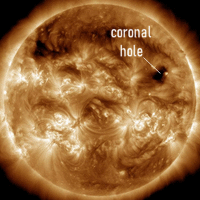
Solar wind flowing from this small coronal hole could graze Earth on July 13-14, causing minor geomagnetic unrest. .Credit: SDO/AIA  Polar Stratospheric Clouds
Colorful Type II polar stratospheric clouds (PSC) form when the temperature in the stratosphere drops to a staggeringly low -85C. NASA's MERRA-2 climate model predicts when the air up there is cold enough: 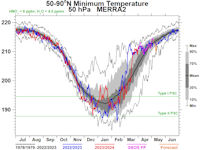
On July 11, 2024, the Arctic stratosphere is much too warm for Type II polar stratospheric clouds. | more data. Noctilucent Clouds
They're back! The northern season for NLCs is underway. The first clouds were detected inside the Arctic Circle on May 25, 2024, by the NOAA 21 satellite. The clouds have since spread, and now observers are seeing from the ground as well:
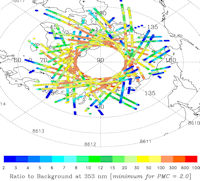
Updated: July 09, 2024
An instrument onboard NOAA 21 (OMPS LP) is able to detect NLCs (also known as "polar mesospheric clouds" or PMCs). In the daily map, above, each dot is a detected cloud. As the season progresses, these dots will multiply in number and shift in hue from blue to red as the brightness of the clouds intensifies.
 SPACE WEATHER
NOAA Forecasts | | Updated at: 2024 Jul 13 2200 UTC FLARE | 0-24 hr | 24-48 hr | CLASS M | 60 % | 60 % | CLASS X | 15 % | 15 % |  Geomagnetic Storms: Geomagnetic Storms:
Probabilities for significant disturbances in Earth's magnetic field are given for three activity levels: active, minor storm, severe storm Updated at: 2024 Jul 13 2200 UTC Mid-latitudes | 0-24 hr | 24-48 hr | ACTIVE | 40 % | 30 % | MINOR | 30 % | 15 % | SEVERE | 15 % | 01 % | High latitudes | 0-24 hr | 24-48 hr | ACTIVE | 05 % | 15 % | MINOR | 25 % | 30 % | SEVERE | 70 % | 45 % | | | |  | | | | | | | | | | | This is an AI Free Zone! Text created by Large Language Models is spreading rapidly across the Internet. It's well-written, artificial, frequently inaccurate. If you find a mistake on Spaceweather.com, rest assured it was made by a real human being. | | | SOLAR FLARE AND RADIO BLACKOUT: Big sunspot AR3738 unleashed an M5.3-class solar flare today, July 13th, at 1242 UT. Radiation from the flare ionized the top of Earth's atmosphere, causing a shortwave radio blackout over Europe and Africa. So far, no CME has been detected emerging from the blast site. Solar flare alerts: SMS Text
HUGE OUTBREAK OF NLCS: European observers are reporting a "huge outbreak" of noctilucent clouds (NLCs) on July 13th. "There were NLCs all around the sky!" says Ujvárosi Beáta of Vácrátót, Hungary: 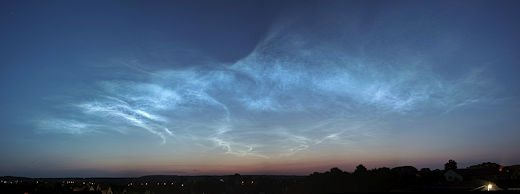
"This is really rare at our latitude (+47N)," says Beáta. "It was a memorable and special display." Similar reports have been received from France, Finland, Latvia, and Norway. This is the latest example of NLCs defying expectations. Made of frosted meteor smoke near the edge of space, the clouds are supposed to be melted away by high solar activity. Solar Max arrived in 2024, yet observers continue to witness some of the best NLCs in years. Extra water vapor injected into the mesosphere by intensifying space traffic and the Tonga volcano may be counteracting the effect of the active sun. Realtime Noctilucent Cloud Photo Gallery
Free: Spaceweather.com Newsletter FIRST SIGHTINGS OF THE EVENING STAR: After months hiding in the sun's glare, Venus is back. Peter Lowenstein saw the Evening Star from Mutare, Zimbabwe on Friday, July 12th: 
"These pictures, taken between 5.07 and 5.52 pm on Friday, July 12th, show that Venus has separated far enough from the sun to appear in the sunset," says Lowenstein. "These are our first views of Venus after sunset in July 2024." The view will soon improve. Every night for the rest of 2024, Venus will move farther away from the sun, becoming increasingly visible in the evening sky. When will your first sighting be? Submit your photos here. more images: from Stephen Biggs of Victoria, BC, Canada Realtime Space Weather Photo Gallery
Free: Spaceweather.com Newsletter GLOW-IN-THE-DARK AURORA PENDANT: Are you looking for a far-out gift? Consider the Glow-in-the-Dark Aurora Pendant. On July 8, 2024, it flew to the stratosphere onboard an Earth to Sky Calculus cosmic ray research balloon: 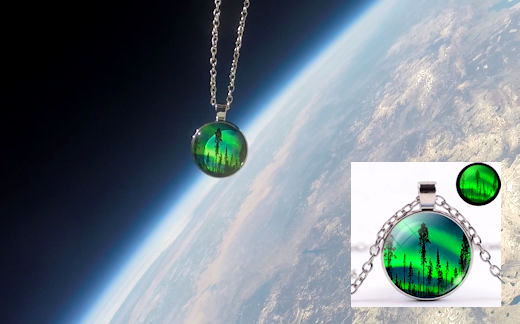
You can have it for $99.95. For 3 hours, the necklace floated 106,444 feet above the Sierra Nevada mountains of central California while radiation sensors inside the balloon's payload gathered data for the students' cosmic ray monitoring project. It comes with a greeting card showing the pendant in flight and explaining the Earth to Sky Calculus radiation experiment. The students of Earth to Sky Calculus are selling space jewelry to support their cosmic ray ballooning program. Don't wait for Christmas--get yours now! Far Out Gifts: Earth to Sky Store
All sales support hands-on STEM education
Realtime Comet Photo Gallery
Free: Spaceweather.com Newsletter
Realtime Aurora Photo Gallery
Free: Spaceweather.com Newsletter
Every night, a network of NASA all-sky cameras scans the skies above the United States for meteoritic fireballs. Automated software maintained by NASA's Meteoroid Environment Office calculates their orbits, velocity, penetration depth in Earth's atmosphere and many other characteristics. Daily results are presented here on Spaceweather.com. On Jul 13, 2024, the network reported 9 fireballs.
(8 sporadics, 1 alpha Capricornid) 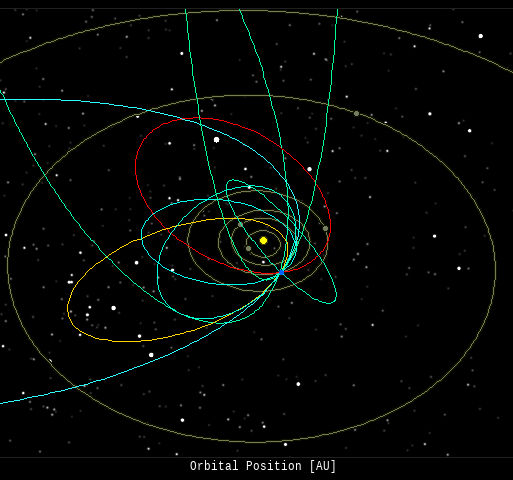 In this diagram of the inner solar system, all of the fireball orbits intersect at a single point--Earth. The orbits are color-coded by velocity, from slow (red) to fast (blue). [Larger image] [movies] Potentially Hazardous Asteroids ( PHAs) are space rocks larger than approximately 100m that can come closer to Earth than 0.05 AU. None of the known PHAs is on a collision course with our planet, although astronomers are finding new ones all the time. On July 13, 2024 there were 2349 potentially hazardous asteroids.
 | Recent & Upcoming Earth-asteroid encounters: | Asteroid | Date(UT) | Miss Distance | Velocity (km/s) | Diameter (m) | | 2024 MT1 | 2024-Jul-08 | 3.9 LD | 18.1 | 79 | | 2024 NB1 | 2024-Jul-09 | 14.6 LD | 9.7 | 63 | | 2024 NR1 | 2024-Jul-09 | 16.9 LD | 8.4 | 26 | | 2024 NA2 | 2024-Jul-09 | 5.9 LD | 4.1 | 33 | | 2024 ME1 | 2024-Jul-10 | 11.3 LD | 8.4 | 40 | | 2022 YS5 | 2024-Jul-11 | 11 LD | 5.8 | 38 | | 2024 NG | 2024-Jul-13 | 9 LD | 7 | 18 | | 2024 NB2 | 2024-Jul-13 | 10 LD | 13.3 | 33 | | 2024 BY15 | 2024-Jul-16 | 16.2 LD | 0.7 | 16 | | 2024 NJ3 | 2024-Jul-17 | 3.2 LD | 6.5 | 14 | | 2024 NF | 2024-Jul-17 | 12.6 LD | 20.3 | 71 | | 2024 MG1 | 2024-Jul-21 | 11.1 LD | 9.3 | 58 | | 2024 NH | 2024-Jul-23 | 13.1 LD | 5.5 | 29 | | 2024 LY2 | 2024-Jul-23 | 12 LD | 7.8 | 94 | | 2011 MW1 | 2024-Jul-25 | 10.1 LD | 8 | 120 | | 2024 NV1 | 2024-Jul-25 | 14.1 LD | 10.2 | 31 | | 2024 MH1 | 2024-Jul-26 | 4.7 LD | 5.8 | 27 | | 2011 AM24 | 2024-Jul-26 | 16.8 LD | 6.2 | 281 | | 2024 NZ1 | 2024-Jul-28 | 19.6 LD | 12.8 | 56 | | 523664 | 2024-Jul-28 | 14.9 LD | 23.7 | 680 | | 2024 NS1 | 2024-Aug-02 | 5.3 LD | 7.6 | 52 | | 2020 PN1 | 2024-Aug-02 | 18 LD | 5.5 | 29 | | 2023 HB7 | 2024-Aug-05 | 14.6 LD | 6.1 | 32 | | 2017 TU1 | 2024-Aug-05 | 10.1 LD | 10.1 | 22 | | 2024 KH3 | 2024-Aug-10 | 14.6 LD | 11.4 | 196 | | 2021 GY1 | 2024-Aug-16 | 17.7 LD | 6.3 | 59 | | 2024 JV33 | 2024-Aug-19 | 12 LD | 11.1 | 207 | | 2022 BF2 | 2024-Aug-19 | 19.7 LD | 16.4 | 91 | | 2020 RL | 2024-Aug-27 | 12.2 LD | 8.2 | 34 | | 2021 RA10 | 2024-Aug-28 | 6.8 LD | 4.9 | 29 | | 2012 SX49 | 2024-Aug-29 | 11.2 LD | 4.3 | 20 | | 2016 RJ20 | 2024-Aug-30 | 18.3 LD | 14.8 | 68 | | 2021 JT | 2024-Sep-01 | 16.4 LD | 8.2 | 12 | | 2021 RB16 | 2024-Sep-02 | 12.3 LD | 8.4 | 15 | | 2007 RX8 | 2024-Sep-02 | 18.5 LD | 7 | 44 | | 2022 SR | 2024-Sep-07 | 9.1 LD | 6.3 | 42 | | 2023 SP2 | 2024-Sep-09 | 15.3 LD | 4.2 | 8 | Notes: LD means "Lunar Distance." 1 LD = 384,401 km, the distance between Earth and the Moon. 1 LD also equals 0.00256 AU. | | Cosmic Rays in the Atmosphere | SPACE WEATHER BALLOON DATA: Almost once a week, Spaceweather.com and the students of Earth to Sky Calculus fly space weather balloons to the stratosphere over California. These balloons are equipped with sensors that detect secondary cosmic rays, a form of radiation from space that can penetrate all the way down to Earth's surface. Our monitoring program has been underway without interruption for 7 years, resulting in a unique dataset of in situ atmospheric measurements. Latest results (July 2022): Atmospheric radiation is decreasing in 2022. Our latest measurements in July 2022 registered a 6-year low: 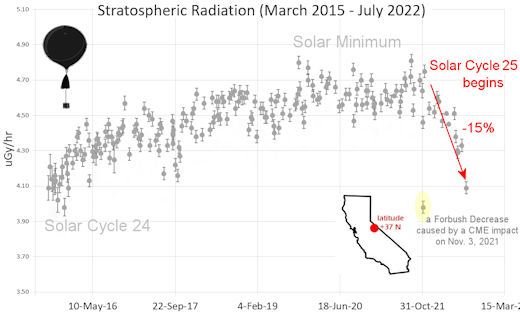
What's going on? Ironically, the radiation drop is caused by increasing solar activity. Solar Cycle 25 has roared to life faster than forecasters expected. The sun's strengthening and increasingly tangled magnetic field repels cosmic rays from deep space. In addition, solar coronal mass ejections (CMEs) sweep aside cosmic rays, causing sharp reductions called "Forbush Decreases." The two effects blend together to bring daily radiation levels down. .Who cares? Cosmic rays are a surprisingly "down to Earth" form of space weather. They can alter the chemistry of the atmosphere, trigger lightning, and penetrate commercial airplanes. According to a study from the Harvard T.H. Chan school of public health, crews of aircraft have higher rates of cancer than the general population. The researchers listed cosmic rays, irregular sleep habits, and chemical contaminants as leading risk factors. A number of controversial studies (#1, #2, #3, #4) go even further, linking cosmic rays with cardiac arrhythmias and sudden cardiac death. Technical notes: The radiation sensors onboard our helium balloons detect X-rays and gamma-rays in the energy range 10 keV to 20 MeV. These energies span the range of medical X-ray machines and airport security scanners. Data points in the graph labeled "Stratospheric Radiation" correspond to the peak of the Regener-Pfotzer maximum, which lies about 67,000 feet above central California. When cosmic rays crash into Earth's atmosphere, they produce a spray of secondary particles that is most intense at the entrance to the stratosphere. Physicists Eric Regener and Georg Pfotzer discovered the maximum using balloons in the 1930s and it is what we are measuring today. | | The official U.S. government space weather bureau | | | The first place to look for information about sundogs, pillars, rainbows and related phenomena. | | | Researchers call it a "Hubble for the sun." SDO is the most advanced solar observatory ever. | | | 3D views of the sun from NASA's Solar and Terrestrial Relations Observatory | | | Realtime and archival images of the Sun from SOHO. | | | information about sunspots based on the latest NOAA/USAF Active Region Summary | | | current counts of failed and deployed Starlink satellites from Jonathan's Space Page. See also, all satellite statistics. | | | Authoritative predictions of space junk and satellite re-entries | | | from the NOAA Space Environment Center | | | fun to read, but should be taken with a grain of salt! Forecasts looking ahead more than a few days are often wrong. | | | from the NOAA Space Environment Center | | | the underlying science of space weather |  | Got a chipped or cracked windshield that prevents you from seeing space weather events while driving? Get windshield replacement from SR Windows & Glass with free mobile auto glass service anywhere in the Phoenix area. |  | Marketing yourself on YouTube is hard without real organic views on your videos. You can buy organic YouTube views from and enjoy social boosting that is actually real. Highly recommended! |  | BestCSGOGambling is the best site for everything related to CSGO gambling on the web | | | These links help Spaceweather.com stay online. Thank you to our supporters! | | | | | | | | |  | |  |   | ©2021 Spaceweather.com. All rights reserved. This site is penned daily by Dr. Tony Phillips. | |

